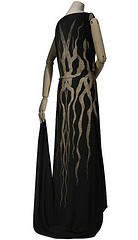 The names of Chanel and Schiaparelli are usually the first to spring to mind when we think about the 1930s, arguably the most exciting era in fashion history. In comparison, few are familiar with Madeleine Vionnet who was at the forefront of this decade. This woman was more than just the designer who introduced the revolutionary bias cut, she's one of the most influential designers of the last century.
The names of Chanel and Schiaparelli are usually the first to spring to mind when we think about the 1930s, arguably the most exciting era in fashion history. In comparison, few are familiar with Madeleine Vionnet who was at the forefront of this decade. This woman was more than just the designer who introduced the revolutionary bias cut, she's one of the most influential designers of the last century.  Born in France, 1876, Vionnet first apprenticed as a seamstress at the age of 11. Married at 18, she left her first husband the following year to work in London as a hospital seamstress. She returned to Paris and trained at famed fashion house Callot Soeurs and then designed for the Doucet Salon until 1911. In 1912, she opened Maison Vionnet. Global fame arrived in the 1920s with her sensational bias cut technique where the cloth was cut diagonally to the grain of the fabric. This allowed the material to softly shape and cling to the body giving an overall sleek and flattering look.
Born in France, 1876, Vionnet first apprenticed as a seamstress at the age of 11. Married at 18, she left her first husband the following year to work in London as a hospital seamstress. She returned to Paris and trained at famed fashion house Callot Soeurs and then designed for the Doucet Salon until 1911. In 1912, she opened Maison Vionnet. Global fame arrived in the 1920s with her sensational bias cut technique where the cloth was cut diagonally to the grain of the fabric. This allowed the material to softly shape and cling to the body giving an overall sleek and flattering look.Vionnet hated corsets, padding, darts and any other unnecessary adornments. She preferred to accentuate a woman's natural curves. Inspired by Greek art, her garments were fluid on the body without distorting it's shape which allowed for flowing movement and comfort - a feat in itself when you consider the stiff corsets and under dress layers of the day. She used uncommon materials like satin and crêpe de chine and would order fabrics two yards wider than needed to accommodate draping. Although her styles appear to be simple, much work went into each creation. Vionnet would first prepare the original design on a doll before making the life-size version.
Vionnet was very much a woman ahead of her time. She actively fought for copyright laws in fashion. In 1923, she co-founded the first anticopyist association and established another in 1929. So adamant was she on authentication that her label featured her signature with an imprint of her right thumb. In 1925, Madeleine Vionnet Inc. on Fifth Avenue was the first French fashion house to open in New York. The shop carried easily sized styles with unfinished hems that could be custom altered. She is also believed to be responsible for the first haute couture prêt-à-porter line (ready to wear) for US wholesale. These were labeled “Repeated Original” along with her signature.
At it's height during the 1930s, Maison Vionnet employed 1200 seamstresses. The benefits she extended to her employees were far from the standard labor practices of the day. She offered paid holidays, daycare and maternity leave. On the premises was a clinic with a resident doctor and dentist as well as a dining hall and gym. Like those copyright laws, these benefits were all unheard of a century ago.
 Vionnet lived like a hermit who shunned the fashion world and the spotlight. She said,"Insofar as one can talk of a Vionnet school, it comes mostly from my having been an enemy of fashion. There is something superficial and volatile about the seasonal and elusive whims of fashion which offends my sense of beauty." The House of Vionnet closed at the onset on WWII and though she would act as a mentor for future designers, she retired completely from the fashion world saying she "had nothing more to say" even though she lived until 1975.
Vionnet lived like a hermit who shunned the fashion world and the spotlight. She said,"Insofar as one can talk of a Vionnet school, it comes mostly from my having been an enemy of fashion. There is something superficial and volatile about the seasonal and elusive whims of fashion which offends my sense of beauty." The House of Vionnet closed at the onset on WWII and though she would act as a mentor for future designers, she retired completely from the fashion world saying she "had nothing more to say" even though she lived until 1975. The house was reopened in 1996 by the Lummen family with a line of accessories and perfumes. Their first clothing collection was launched Spring/Summer 2007 under the direction of Sophia Kokosalaki who was replaced by Marc Audibet that same year. In 2009 it took another direction when Matteo Marzotto (formerly of Valentino) acquired the label. It's been a rough start for sure but that same year Vionnet dresses made a long overdue return to the red carpet courtesy of Hilary Swank.
Madeleine Vionnet lives on through those B&W photos of the Hollywood actresses we most associate with glamour like Mae West who was a huge fan of her bias cut. Among her other creations were the handkerchief dress, cowl neck and halter top; mainstays of both the Paris runways and dress racks at Walmart. Not too many designers can make that claim and truly, every single one of her gowns can still be worn today.







No comments:
Post a Comment